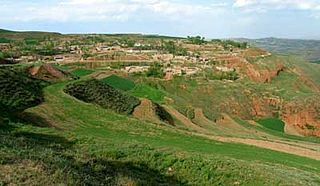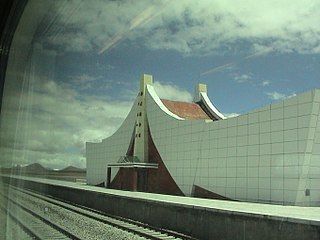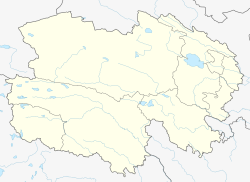
Golmud, also known by various other romanizations, is a county-level city in the Haixi Mongol and Tibetan Autonomous Prefecture of Qinghai Province, China. It is now the second-largest city in Qinghai and the third largest in the Tibetan Plateau. The population in 2020 is 221,863.
Khams Tibetan is the Tibetic language used by the majority of the people in Kham. Khams is one of the three branches of the traditional classification of Tibetic languages. In terms of mutual intelligibility, Khams could communicate at a basic level with the Ü-Tsang branch.

Seni District is a district within the Nagqu of the Tibet Autonomous Region, China.
Baima is a town in Baxoi County, Chamdo Prefecture of the Tibet Autonomous Region of the People's Republic of China. It lies at an altitude of 3,772 metres (12,378 ft). As of 2020, it administers Baima Residential Community and the following eight villages:

Gertse County, Gêrzê County or Gaize County is a county located in Ngari Prefecture in the northwest of the Tibet Autonomous Region, China, bordering Xinjiang to the north.

Taktser or Tengtser or Hongya Village is a village in Shihuiyao Township, Ping'an District, Haidong, in the east of Qinghai province, China. Tibetan, Han and Hui Chinese people populate the village which is notable as the birthplace of the 14th Dalai Lama, Tenzin Gyatso.
Domar, Duoma or Duomaxiang is a village and township-level division of Shuanghu County in the Nagqu Prefecture of the Tibet Autonomous Region, in China. It is located roughly 140 kilometres (87 mi) west of Amdo Town and roughly 50 kilometres (31 mi) north of Siling Co, near the western bank of a lake at the foot of the Tanggula Mountains. As of 2004 it had a population of 1,488 people.
Puqu or Burqug is a township located in the south of Bayi District, Nyingchi, Tibet Autonomous Region, China.
Gangnyi, Gangni, Gangnyixiang or Gangnixiang is a village and township-level division of Amdo County in the Nagqu Prefecture of the Tibet Autonomous Region, in China. It is located roughly 60 kilometres (37 mi) northwest of Amdo Town. The township covers an area of 5,019 kilometres (3,119 mi) and as of 2004 it had a population of around 1,300. The principal economic activity is animal husbandry, pastoral yak, goat, sheep, and so on.
Sewu, Sêwa or Sewuxiang is a village and township-level division of Amdo County in the Nagqu Prefecture of the Tibet Autonomous Region, in China. It lies near Qixiang Lake. The township covers an area of 5,647 kilometres (3,509 mi) and in 2004 it had a population of about 1,000. The principal economic activity is animal husbandry, pastoral yak, goat, sheep, and so on.
Jiaqiong or Jakhyung Town, also known as Jongnag is a small town and township-level division in Baingoin County, Nagqu in the Tibet Autonomous Region of the People's Republic of China. It covers an area of 2,993 square kilometres (1,156 sq mi) and as of 2010 it had a population of 2926 people. Jiaqiong lies to the northwest of Beila, to the east of Amdo County, and south of Shuanghu County.
Lhari is a small town and seat of Lhari County in the Nagqu Prefecture of the Tibet Autonomous Region, in China. It is located northeast of Lhasa, southeast of Nagchu Town, southwest of Banbar Town and north of Gongbo'gyamda. In 2004 it had a population of about 1,000.
Zharen, also Zaring or Zharencun is a small town and township-level division of Amdo County in the Nagqu Prefecture of the Tibet Autonomous Region, in China. It is located at the side of the G109 road, 41.9 kilometres (26.0 mi) south of Amdo Town on the road from Nagchu Town, and approximately 20 kilometres (12 mi) east of the southern tip of Cona Lake. It has a population of 7875, living in 1479 households.
Namling or Namlingxoi is a town and seat of Namling County in the Tibet Autonomous Region of China, about 72 kilometres (45 mi) by road northeast of Shigatse, north of Dobjoi.
Xainza is a town and township-level administrative unit and seat of Shentsa County or Xainza County, Nagqu Prefecture, Tibet Autonomous Region, China.

Tanggulashan, or Dangla Town, is a town in the southwest of Qinghai province, China. It forms the southern exclave of the county-level city of Golmud, in Haixi Mongol and Tibetan Autonomous Prefecture, partially administrated by Amdo County, Tibet Autonomous Region since 1963 and still officially a territory of Yushu Prefecture, Qinghai under trust administration of Golmud, Haixi Prefecture, Qinghai. Before the local administrative reform of 2005, it was known as Tanggula Township (唐古拉乡). It is the only place in China simultaneously under jurisdiction of three prefectures.
Baidi is a small village in Baidi Township, Nagarzê County, Lhoka (Shannan) Prefecture, Tibet Autonomous Region, China. It is located at the western end of Yamdrok Lake. Near the village the Yamdrok Hydropower Station, the largest power station in Tibet, was completed and dedicated in 1996.
Codoi is a small town and township in Lhari County in Nagqu Prefecture of the Tibet Autonomous Region, in China. It had a population of about 16,000 as of 2004.
Pana, or Pagnag, also known as Anduo, or Amdo, is a town and the seat of Amdo County in the Nagqu Prefecture of the Tibet Autonomous Region, in China. It lies 464 kilometres north of Lhasa and 138 km north of Nagqu. As of 2004 its jurisdiction had a population of about 2700, 683 of which were living in the town of Pana. The principal economic activity is animal husbandry, pastoral yak, goat, sheep, and so on. Blueschist outcrops are found in the area. The villagers in recent times organized a railway protecting committee to select locals to monitor the Qinghai-Tibet Railway.
"Constructed on the southern side of the Dangla Mountains, Amdo is a Chinese-style town on the Qinghai-Tibet Highway. The road here leads off to the west, heading towards the Mt. Kailash area via the Changthang Plateau. Many of the buses from Golmud to Lhasa used to stay overnight here."
Qiangma, also Qangma or Qiangmazhen is a small town and township-level division of Amdo County in the Nagqu Prefecture of the Tibet Autonomous Region, in China. It is located just south of Zi Getangcuo Lake, 90.7 kilometres (56.4 mi) southwest of Amdo Town. It covers an area of 5,467 square kilometres (2,111 sq mi) and as of 2004 it had a population of about 1700. The principal economic activity is animal husbandry, pastoral yak, goat, sheep, and so on.







